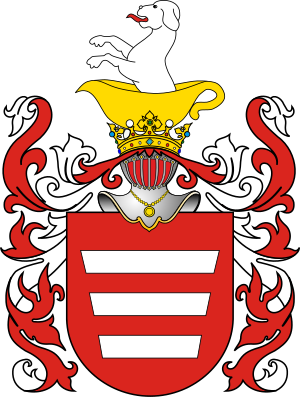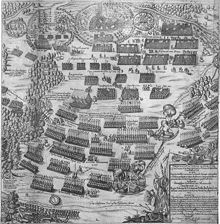Mikołaj Struś

Mikołaj Struś(1577–1627) (Korczak coat of arms) was a Colonel of thePolish Army,astarostaand commandant of the Polish-Lithuanian garrison in the occupiedMoscow Kremlin.He was the last known member of the Strus family ofKomarow-Osada.His father was Jakub Strus, and mother was Barbara Potocka.
Strus began military service probably in 1590 or 1591. On March 7, 1591, he was granted royal permission to own real estate nearKamieniec Podolski.In the following years, he took part in a number of wars and military conflicts in eastern areas of thePolish–Lithuanian Commonwealth,as well as inMoldavia,Livoniaand theTsardom of Russia.In 1595, he probably participated in a raid on Moldavia, carried out by CrownHetmanJan Zamoyski.In 1596, serving underStanislaw Zolkiewski,he pacified theNalyvaiko Uprising.In 1600, he once again fought in Moldavia, fighting againstMichael the Brave.
In 1601 - 1602, Strus fought against theKingdom of Swedenin thePolish–Swedish War (1600–29).Among others, he participated in theSiege of Wolmar,Siege of Fellinand theSiege of Weissenstein.
On January 19, 1602 inVilnius,Strus, as an envoy of Polish cavalry, discussed delayed payments with KingZygmunt III Waza.By 1605, he already was aRittmeisterof aCossackchoragiew,with which he foughtCrimean Tatarsin theBattle of Udycz,on January 28, 1606.
In the autumn 1609, Strus joined theSiege of Smolensk (1609–11),leading a unit of 150Hussars,50 Cossacks and 100 infantry. On July 4, 1610, he fought in theBattle of Klushino,after which he rushed withAleksander ZborowskiandMikolaj Scibor Marchockito King Zygmunt III Waza, presenting to him captured flags of the enemy (July 17). In the spring of 1612, together with 1000 infantry and 3000 cavalry, Strus joined forces of Lithuanian HetmanJan Karol Chodkiewicz,which was sent to reinforce Commonwealth garrison of theMoscow Kremlin.

On June 27, 1612, Strus was named commandant of the garrison, and in September of the same year, under Russian pressure, he agreed for negotiations. On November 7, 1612, Polish-Lithuanian garrison of the Kremlin capitulated: the Russians broke the conditions of the capitulation, and murdered some Polish soldiers. Strus himself was captured and imprisoned in theChudov Monastery,where he stayed for seven years, despite numerous efforts of Polish authorities. He was released on June 10, 1619, half a year after theTruce of Deulino,and immediately rejoined the Commonwealth army, fighting in theBattle of Cecora(September 19, 1620). In this battle, he commanded a unit of 2000 men, and was listed among main leaders of the Polish troops. While fighting, Strus was wounded and captured by Crimean Tatars, who took him with them to Crimea. On July 21, 1621, theszlachtaappealed to King Zygmunt III Waza to initiate negotiations to release Strus. The Tatars released him probably in early 1622: following this adventure, Strus withdrew from military service, and died in 1627.
Mikolaj Strus owned the towns of Probuzna andStrusow,located nearTrembowla(today part ofUkraine), and the villages of Touste and Hrynkowce inHalych Land.
Sources
[edit]- Polski Slownik Biograficzny. Warszawa - Kraków: Polska Akademia Nauk, 2006.
- Kazimierz Pulaski: Kronika polskich rodów szlacheckich Podola, Wolynia i Ukrainy. Brody: Ksiegarnia Feliksa Westa, 1911.
